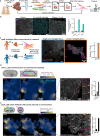This is a preprint.
Spatial Mapping of Mobile Genetic Elements and their Cognate Hosts in Complex Microbiomes
- PMID: 37333098
- PMCID: PMC10274929
- DOI: 10.1101/2023.06.09.544291
Spatial Mapping of Mobile Genetic Elements and their Cognate Hosts in Complex Microbiomes
Update in
-
Spatial mapping of mobile genetic elements and their bacterial hosts in complex microbiomes.Nat Microbiol. 2024 Sep;9(9):2262-2277. doi: 10.1038/s41564-024-01735-5. Epub 2024 Jun 25. Nat Microbiol. 2024. PMID: 38918467 Free PMC article.
Abstract
The frequent exchange of mobile genetic elements (MGEs) between bacteria accelerates the spread of functional traits, including antimicrobial resistance, within the human microbiome. Yet, progress in understanding these intricate processes has been hindered by the lack of tools to map the spatial spread of MGEs in complex microbial communities, and to associate MGEs to their bacterial hosts. To overcome this challenge, we present an imaging approach that pairs single molecule DNA Fluorescence In Situ Hybridization (FISH) with multiplexed ribosomal RNA FISH, thereby enabling the simultaneous visualization of both MGEs and host bacterial taxa. We used this methodology to spatially map bacteriophage and antimicrobial resistance (AMR) plasmids in human oral biofilms, and we studied the heterogeneity in their spatial distributions and demonstrated the ability to identify their host taxa. Our data revealed distinct clusters of both AMR plasmids and prophage, coinciding with densely packed regions of host bacteria in the biofilm. These results suggest the existence of specialized niches that maintain MGEs within the community, possibly acting as local hotspots for horizontal gene transfer. The methods introduced here can help advance the study of MGE ecology and address pressing questions regarding antimicrobial resistance and phage therapy.
Keywords: antimicrobial resistance; bacteriophage; microbial ecology; microbiome; mobile genetic elements; multiplexed imaging; phage therapy; plasmid; single molecule FISH.
Conflict of interest statement
Competing interests H.S. is a co-founder at Kanvas Biosciences. I.D.V. is a member of the Scientific Advisory Board of Karius Inc., and GenDX and co-founder of Kanvas Biosciences. H.S. and I.D.V. are listed as inventors on patents related to multiplexed imaging methods.
Figures




References
-
- Munita J. M. & Arias C. A. Mechanisms of Antibiotic Resistance. in Virulence Mechanisms of Bacterial Pathogens 481–511 (John Wiley & Sons, Ltd, 2016). doi: 10.1128/9781555819286.ch17. - DOI
-
- Khan Mirzaei M. & Deng L. New technologies for developing phage-based tools to manipulate the human microbiome. Trends Microbiol. 30, 131–142 (2022). - PubMed
-
- Rasmussen T. S. et al. Bacteriophage-mediated manipulation of the gut microbiome – promises and presents limitations. FEMS Microbiol. Rev. 44, 507–521 (2020). - PubMed
Publication types
Grants and funding
LinkOut - more resources
Full Text Sources
Research Materials
